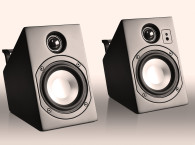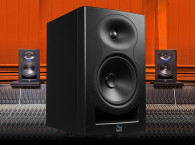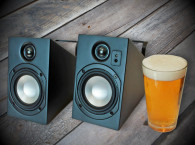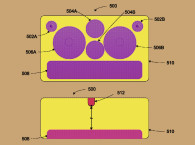
The T1 was Vanatoo’s initial product, and although it was a powered speaker, it still used a conventional passive crossover to the drivers, driven by a single amplifier per channel. The T0 went a step forward and contained separate tweeter and woofer amplifiers in each channel, the crossover being done in the digital domain. This improvement carries several significant advantages: crossover slopes can be much steeper to reduce distortion, delay and phase correction between drivers can result in improved polar patterns, driver/cabinet frequency response errors can be easily corrected digitally, and the crossovers can be modified and updated without changing components. The results of this engineering approach can be seen in my review of the T0 (see Resources), and those speakers are still in daily use here.
I wondered what would happen if Vanatoo applied this approach to an improved version of the T1, and apparently the Vanatoo design team of Gary Geschellen and Rick Kernen were already headed down that path. The result is the Transparent One Encore (T1E), which incorporates all these improvements and more. Retail price for the T1Es is $599 per pair.
Inside the T1E
Compared to the rather oddly shaped T0, the T1E is a much simpler and conventional rectangular box measuring 10” (25 cm) tall, 6.5” (17 cm) wide, and 8” (20 cm) deep (see Photo 1). My review pair were finished in an unobtrusive satin black, but for an upcharge, you can get a cherry wood veneer. The front panel sports a woofer-midrange with a 5.25” (13 cm) diameter concave aluminum cone and a 1” (2.5 cm) dome tweeter. The tweeter has a grill protecting it, which may also have a function controlling dispersion. Crossover between the woofer and the tweeter is at 2 kHz, a rather low frequency for a 1” dome tweeter, but potentially useful for reducing off-axis response gullies as the woofer starts getting more directional.

The woofer has an interesting design, incorporating the XBL technology from Acoustic Development International (see Resources). The XBL technology goes beyond conventional overhung vs. underhung motor assemblies and uses a split dual-magnetic structure and a short coil. As the coil leaves one of the magnetic fields, it enters the other, which flattens out both the BL and inductance vs. displacement curves, linearizing the driver. The convex dust cap dome used for the T1’s woofer has been replaced by a smooth concave dust cap; Vanatoo claims that this change is purely cosmetic and has no acoustic effects in the woofer’s passband.
The woofer is a very heavy and solid unit, with the area behind the cone damped by the acoustic resistance of a perforated metal basket (see Photo 2). The large magnet suggests that the driver has high electrical damping as well. On the back panel (see Photo 3), there’s a passive radiator, which takes over from the woofer below the box tuning frequency, extending the bass response. My own prejudices are in favor of passive radiators rather than ports, since the former do not suffer from moving air noises (chuffing), pipe resonances, or reflections from the enclosure’s back wall. The T1E’s passive radiator has a higher mass than the one used for the original T1, which is used to lower the box tuning frequency from 48 Hz in the T1s to 40 Hz in the T1Es. This gives the T1E slightly better bass extension than its predecessor. The bass roll-off is also shaped to give higher output and lower distortion by increasing the roll-off slope below the tuning frequency from the usual (for a reflex or passive radiator system) 24 dB/octave to 48 dB/octave.
Likewise, the tweeter is new — an aluminum dome replaces the older version’s silk dome. Vanatoo tells me that the older driver performed well, but there were some inconsistencies from unit to unit. This isn’t surprising given the variability of natural materials like silk and the inherent variability of the coating/doping process. Aluminum domes are easier to make consistently, and the performance data, as we shall see, show no signs of the bugaboo of metal domes, ringing at the top of the audio passband. These are remarkably high-quality drivers for a loudspeaker in this price range.
As with the T0, the T1E houses all of the electronics in one of the speakers, with a cable connection between the “live” speaker and the other channel. The amplification, which is entirely Class D for efficiency and performance, has crossover, equalization, and delay built into it, and is scaled for the efficiency of the respective drivers. The woofer amplifiers put out 100 W maximum, with the tweeters being driven with 12 W. The digital signal processing (DSP) in the electronics also includes limiters and compression, which kick in at high power to prevent driver damage when the speakers are being pushed hard. These limiters can be disabled by the user, but that can result in the overdriven speakers distorting rather than smoothly compressing.
In my case, I never had them loud enough to have the limiting kick in, but if you’re fond of concert rock at ear-splitting levels, the choice between a rather smooth compression vs. gross distortion on peaks and bass-heavy material is yours to make. I would be cautious about turning this function off purely from a reliability standpoint; burnt out drivers are an expensive repair.

The T0 used an Ethernet cable to connect the two speakers, whereas the T1E uses a heftier-feeling cable with screw-on connectors. The speakers are supplied with a 6 m long cable, which should suffice for the majority of installations, but Vanatoo can also supply a 2 m or 10 m long cable, if needed. Using a slide switch on the rear panel of the “active” speaker, the user can select whether the electronics containing speaker is used for the left or the right channel.
The back panel also has a variety of input options, including standard line-level single-ended analog (3.5 mm stereo plug), USB, coax, and optical digital inputs, as well as Bluetooth capability using aptX for higher resolution. A nice touch is that the inputs can either be manually selected or automatically detected. The digital input will accept up to 24-bit and 96 kHz sample rate. All internal processing is done at a 48 kHz sample rate, which exceeds CD standards and is good enough for audible transparency.
There’s an enormous flexibility in setup. Besides the left-right swap I mentioned earlier, the speakers have two selectable equalizations for different placements. The “Flat” setting is suitable for stand placement away from room boundaries (the way I used the speakers). “Shelved” will reduce bass output for placement against walls, on shelves, or on a desktop, where the boundary creates bass reinforcement in order to yield an overall flat bass.
Speaking of bass, the T1Es have an output for active subwoofers if extension below the T1Es’ -3 dB point of 48 Hz is necessary. When a subwoofer is connected to that output, the T1E automatically sets a high-pass crossover point. In Flat mode, that point is 80 Hz; in Shelved mode, it changes to 125 Hz.
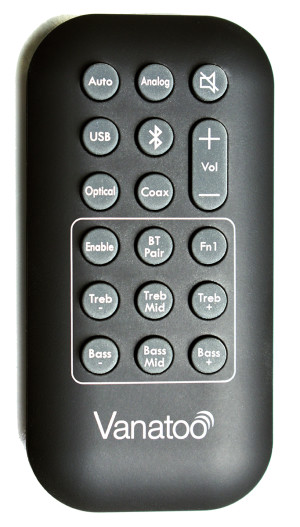
relatively compact, convenient, and intuitive to use.
One of the minor complaints I had with the T0 model was the method to change parameters. Each parameter change (e.g., bass, treble, EQ, limiters, left-right swapping, LED brightness, stereo/mono) required a rather elaborate procedure of powering down, waiting a minute or two, setting the volume control to a specific point, setting a three-way switch to a specific setting, then powering up while depressing the Bluetooth pairing button. The three-way switch was needed to reconfigure the single control to bass, treble, or volume. This has been improved somewhat in the T1E, which now has separate volume, treble, and bass controls, as well as a physical switch to determine whether the active speaker is on the left or right, though the elaborate procedure for other options remains.
Like Vanatoo’s earlier speaker models, the T1E’s volume, source, and bass/treble can also be adjusted with an included remote control (see Photo 4). The controls are logical and intuitive — a nice feature is that the functions within the lower block outline are only active after the user first pushes the “Enable” button. The user then has a 15-second window to make tone adjustments or pair/unpair Bluetooth sources. This prevents clumsy fingers (who, me?) from accidentally changing parameters causing the user to wonder, “What went wrong?” The tone controls have a “mid” option, which returns them to a flat setting. Pressing the + and – buttons increases and decreases the bass or treble in 1 dB increments.
If I were to make a suggestion to the Vanatoo folks, it would be to reduce remote clutter (we have three of them already in our living room TV/audio setup) in favor of a smartphone app. This could also reduce the clumsy parameter-change method described above. Nonetheless, remote control is still incredibly useful in active setups, so its inclusion here, even as hardware, is appreciated.
And a minor point — the grilles are attached using magnets rather than pegs, screws, or grommets. This provides a neat appearance and allows an easy transition between listening to the speakers naked and protection from curious fingers and camouflage from living companions who don’t appreciate the visual high-tech splendor of loudspeaker drivers.
Setup and Use
I placed the T1Es on rather inexpensive stands, with the vertical midpoint between tweeter and woofer at my ear level. After some experimentation with room position, the speakers ended up about 6’ (1.8 m) apart, about 4’ (1.2 m) from the side walls, and about 5’ (1.5 m) from the back wall. My seating position was about 7’ (2.1 m) back from the speakers. The tone controls were set to their center detent positions, and the EQ was likewise set to “flat.” Toeing the speakers in slightly improved the imaging; I’d recommend having the axes cross just behind your preferred listening spot.


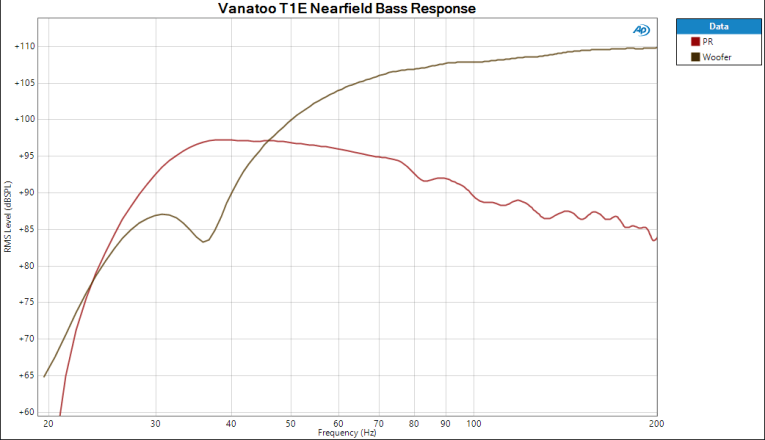
Besides my usual reference speakers, I also pressed some Kali LP-6s (see Resources) into comparative service. The Kalis, primarily designed for studio and mixing use, do not have anything close to the versatility of the T1Es, but are similarly priced and somewhat larger.
Initially, I had a problem — after using the speakers for a couple of weeks, they suddenly went silent. It turns out that a small percentage of the first production run (from which my samples were drawn) had a defective diode on the amplifier board. Reviewer’s luck that I ended up getting one! In any case, for anyone who encounters this problem, Vanatoo offers to either replace the speaker or for those comfortable with electromechanical repair, sending the user a replacement amplifier. I opted for the latter, and doing the amp swap only took 15 minutes or so — the hardest part was getting the terminal clips off the woofer, since they are tight enough to give a gas-tight contact.
Once the amp was replaced, Bluetooth pairing was quick and completely free of adventure. Likewise, there were no issues using optical, coax, and analog inputs. At various times, I fed the T1Es from my laptop computer, my iPhone, and a couple of DACs I had sitting in my lab. All functioned flawlessly — people who want to avoid fuss and fiddling and just want to hear their tunes will be incredibly satisfied with the ease of getting things going and the input versatility. I was particularly struck by the simplicity of hooking up my iPhone and streaming from Amazon HD — basically, the entire array of components in a home stereo vanished, which may not impress audiophile friends, but is perfect for people who have music, not equipment, as front and center in their lives.
The reference material I use for evaluation is an assortment of different acoustic recordings (including my own) that span classical, traditional jazz, folk/Americana, bluegrass, and big band. I also dropped a few rock recordings in there to see if I could get the T1Es to choke up. And the answer is, my ears gave out first. In a small to moderate-size room (mine is about 14’ wide, 20’ long, with an 8’ ceiling), these speakers can play very loudly without obvious strain. I don’t know if the limiters were kicking in, but if they were, their effect was subtle.
My first impression of the T1Es was a very solid bass for their size. Not just solid, but well-defined in a way that the bass of a lot of mini monitors isn’t. Too many mini monitors pursue giving an impression of bass without really delivering; the BBC LS3/5A was a progenitor of that genre, but that sort of midbass hump to fatten things up negatively affects the apparent texture and definition in the bottom three octaves. This is very much not the case here! The very bottom octave isn’t there, of course, but from 40 Hz up (and 40 Hz sounds deeper than you might think), the quality and quantity of bass belie the speakers’ size and price. I was particularly struck by how natural recordings of upright bass sounded — this is where most mini monitors show an extreme weakness, either bloating the sound or eviscerating it. Definitely a strong point of these speakers!
Imaging and soundstage were very, very good — not quite up to the spooky disappearing act of the Vanatoo T0s, but better than most speakers. Localization of instruments is tight and stable with no wandering. Compared to both my reference speakers and the Kali LP-6s, the listening window is a bit more restricted, with both tone and image degrading when I moved more than a couple of feet away from the center.
As far as tonality goes, human voices can be particularly revealing of midrange colorations, so I focused on those. In switching between the reference speakers and the Vanatoos, the T1Es sounded to me slightly forward with a somewhat mellow but very clear upper treble.
To put things into perspective, these were rather small colorations, and perhaps the remarkable clarity of the sound enabled me to pick up on this. Indeed, the clarity and detail of acoustic music is what kept drawing me back, and I didn’t feel a huge urge to get through the review and get back to my main system. By comparison, the Kali LP-6s seemed a bit more neutral, but also did not flatter any mediocre recordings, and of course, could only be driven by one of my balanced DACs.
For completeness, I also set up the T1Es on my desktop, fed by my lab computer. The EQ was reset to “Shelved,” and the resulting sound was full-bodied and well-integrated. One concern for nearfield listening like this is the noise from the power amplifiers; in the case of the T1Es, it was audible as a slight hiss, but it was significantly lower in volume than the hiss from the Kali LP-6s. And the Vanatoos took up significantly less desk space. I’d still prefer the Kalis for mixing and mastering, but for just plain music listening, I preferred using the T1Es.


Measurements
As usual, my measurement setup consisted of an Audio Precision APx525 audio analyzer, an Audio Precision APx1701 acoustic interface, and a PCB Piezotronics 376A32 1/2” calibrated condenser laboratory microphone. For near-field woofer and port measurements, I switched mics to the PCB Piezotronics 376A31 1/4” mic, which has a higher SPL capability than the 376A32. The APx525 optical output was connected via a TOSLINK cable to the T1E’s optical input, with the T1E’s volume control set to its midpoint. Frequency response and distortion measurements were acquired using a swept tone, which is transformed into an impulse response and Fourier transformed after gating out the reflections.
Figure 1 shows the quasi-anechoic on-axis frequency response, taken at six points and power averaged. The most noteworthy overall feature is the generally flat and neutral response up to about 10 kHz, but there’s a notch near the 2 kHz crossover point and a bump at about 3.8 kHz. This may correlate with my impression of a forward sound. The top octave (10 kHz to 20 kHz) is shelved down by 4 dB to 5 dB, which is noticeable in direct comparison to my reference speakers and the Kali LP-6s, but also can make edgier recordings a bit more listenable. Nonetheless, I wish it weren’t there and I could ameliorate poor recordings with the tone controls (see the Breaking News at the end of this review, though). On the positive side, there’s no sign of a break-up resonance in the metal dome tweeter, nor anything similar for the woofer near the top of its passband.
The frequency response at 22.5° and 45° horizontally off axis (see Figure 2) may give some clues about my observations on imaging and tonality. The response is very consistent at the smaller angle, which certainly was a positive as far as localization. At larger angles, things fall apart a bit, which may be related to the baffle size and geometry. I saw smoother behavior at those angles with the T0, perhaps because of the T0’s smaller baffle and non-rectangular shape, and the T0 seemed to disappear more than most other speakers, including the T1E. Figure 3 shows the near-field response of the woofer and the passive radiator. The 40 Hz tuning is evident, as is the strong output down to that frequency. The T1Es did not sound at all thin or bass-shy, as well as showing no bloatedness or fake midbass boosting, and here’s data showing why.


The distortion spectra are also of interest. Figures 4–6 show the distortion at 100 Hz, 1 kHz, and 3 kHz, respectively. The background room noise (dominated by the fans of the Audio Precision test gear) is shown in the red curves as a baseline. These aren’t championship results, but they are still quite good, and for the price and size are extremely good. The 100 Hz distortion in particular is quite low for a driver this small. Note that the XBL technology seems to nearly eliminate fourth-order and higher even harmonics, and reduces the level of second harmonic, which in most conventional designs is the principal distortion component.
Figure 7 shows the effect of the treble tone control, with settings at the center detent (12:00), slightly turned down (10:00), and slightly turned up (2:00). At maximum and minimum, the response changes almost 10 dB, but as can be seen here, it’s easy to get more subtle and tasteful adjustments.
Overall, the measurements here are quite good and show both thoughtful engineering trade-offs and a few minor areas where improvements could be implemented in future updates.
Conclusions
After having several pairs of the latest generation of powered speakers cycling though my lab and living room, I am still amazed at what modern design and characterization tools, materials, and smart engineering can do to narrow the gap between state-of-the-art and state-of-the-affordable. Besides sounding great, the T1Es offer music lovers a simple and versatile package that can be easily configured to be used in rooms or on desktops, and fed by just about any imaginable source. If your priority is getting the music playing rather than fiddling with impressive equipment, the Vanatoo Transparent One Encore will more than satisfy you.
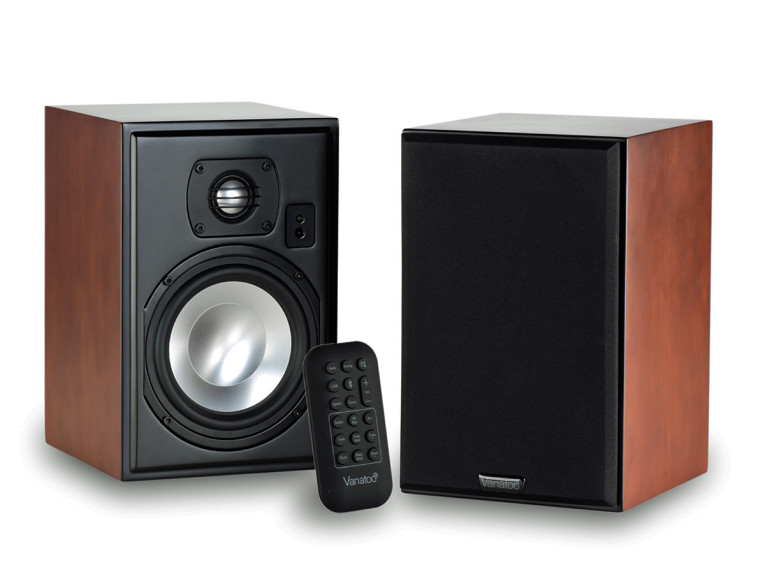
Breaking News
As of press-time, Vanatoo has released a firmware update (version 5.17), which is intended to fix a few of the minor frequency response issues I saw, as well as clean up some aspects of the polar pattern at larger angles. After some small adventures getting the firmware to load, the updates were implemented. My early impressions are that the new firmware fixed the two minor sonic issues I noted, the slight forwardness and the top octave droop. aX
Resources
D. Wiggins, “XBL: A Primer,” Acoustic Development International, 2008, http://www.acousticdev.com/Files/XBLPrimer.pdf
S. Yaniger, “Vanatoo Transparent Zero Powered Speakers,” audioXpress, January 2018, https://www.audioxpress.com/files/attachment/2641
S. Yaniger, “Kali Audio LP-6 Powered Studio Monitors,” audioXpress, August 2019, https://www.audioxpress.com/files/attachment/2689
About the Author
Stuart Yaniger has been designing and building audio equipment for nearly half a century, and currently works as a technical director for a large industrial company. His professional research interests have spanned theoretical physics, electronics, chemistry, spectroscopy, aerospace, biology, and sensory science. One day, he will figure out what he would like to be when he grows up.
This article was originally published in audioXpress, February 2020.




